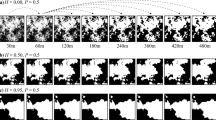Abstract
Ina recent paper [Landscape Ecol. 15: 591–601 (2000)] He et al. describedanaggregation index AI i to measure pixelaggregation within a single class i. We show that thecommonly used shape index SI i is related to theproposed aggregation metric as SI i =Φ(A i) +AI i(1 −Φ(A i)), withΦ(A i) dependent on class areaA i only. Moreover, it is shown that thenormalized shape index, SI i *,equals (1 − AI i). We conclude thatAI i does not provide any information notprovided by SI i, orSI i *.
Similar content being viewed by others
References
Bogaert J., Rousseau R., Van Hecke P. and Impens I. 2000. Alternative area-perimeter ratios for measurement of 2-D shape compactness of habitats. Applied Mathematics and Computation 111: 71-85.
Bribiesca E. 1997. Measuring 2-D shape compactness using the contact perimeter. Computers and Mathematics with Applications 33: 1-9.
He H.S., DeZonia B.E. and Mladenoff D.J. 2000. An aggregation index (AI) to quantify spatial patterns of landscapes. Landscape Ecology 15: 591-601.
Johnsson K. 1995. Fragmentation index as a region based GIS operator. International Journal of Geographical Information Systems 9: 211-220.
McGarigal K. and Marks B.J. 1995. FRAGSTATS: spatial pattern analysis program for quantifying landscape structure. Gen. Tech. Rep. PNW-GTR-351. US Department of Agriculture, Forest Service, Pacific Northwest Research Station, Portland, OR, USA, 122 p.
Miller J.N., Brooks R.P. and Croonquist M.J. 1997. Effects of landscape patterns on biotic communities. Landscape Ecology 12: 137-153.
Milne B.T. 1991. Lessons from applying fractal models to landscape patterns. In: Turner M.G. and Gardner R.H. (eds), Quantitative Methods in Landscape Ecology-The Analysis and Interpretation of Landscape Heterogeneity. Springer-Verlag, New York, NY, USA, pp. 199-235.
O’Neill R.V., Krummel J.R., Gardner R.H., Sugihara G., Jackson B., DeAngelis D.L. et al. 1988. Indices of landscape pattern. Landscape Ecology 1: 153-162.
Pearson S.M., Turner M.G. and Urban D.L. 1999. Effective exercises in teaching landscape ecology. In: Klopatek J.M. and Gardner R.H. (eds), Landscape Ecological Analysis-Issues and Applications. Springer-Verlag, New York, NY, USA, pp. 335-368.
Author information
Authors and Affiliations
Rights and permissions
About this article
Cite this article
Bogaert, J., Myneni, R.B. & Knyazikhin, Y. A mathematical comment on the formulae for the aggregation index and the shape index. Landscape Ecol 17, 87–90 (2002). https://doi.org/10.1023/A:1015204923187
Issue Date:
DOI: https://doi.org/10.1023/A:1015204923187




